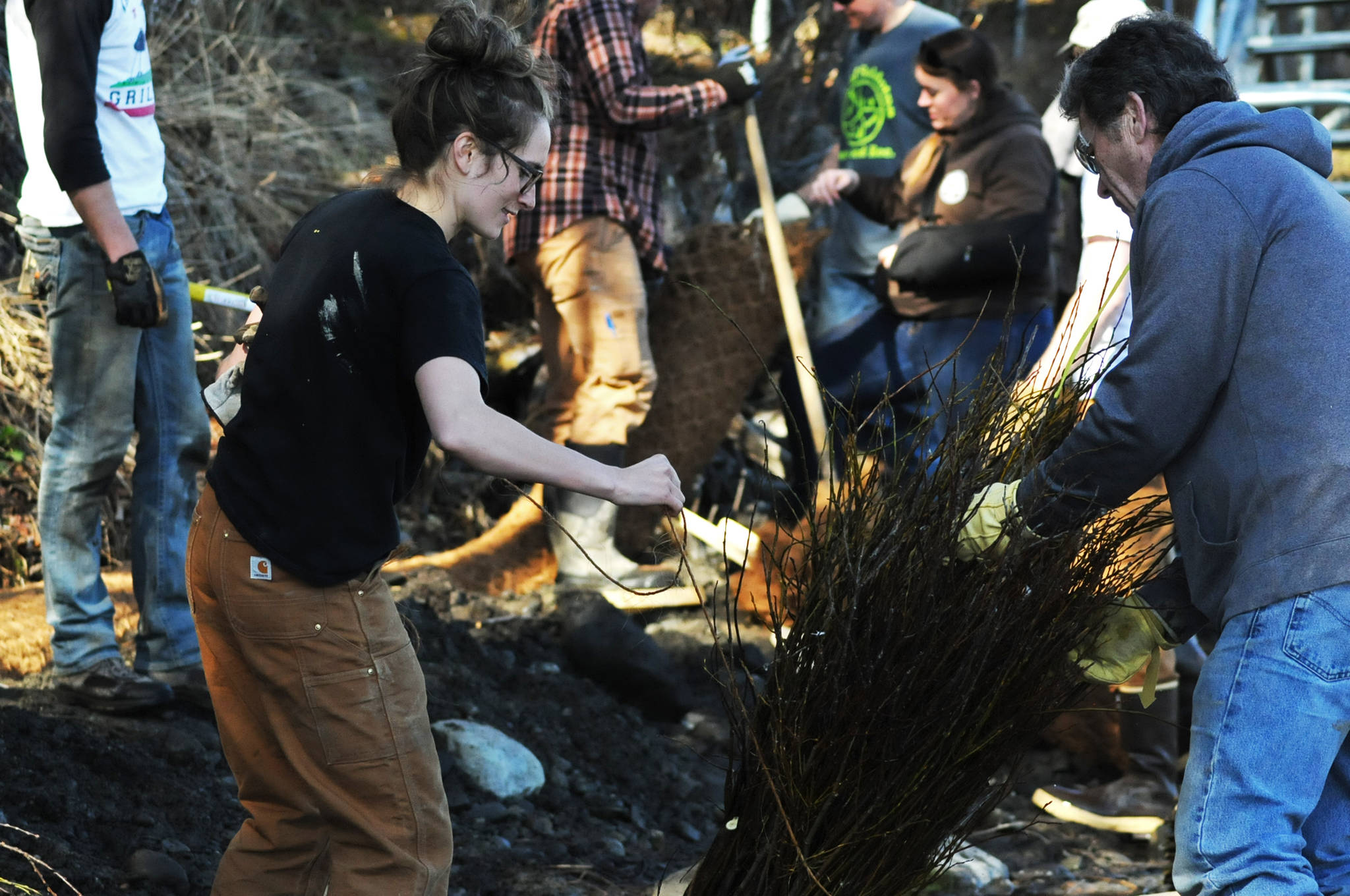A sunny, warm Wednesday in Soldotna found about 40 people busily digging trenches and mounting willow boughs into the banks of the Kenai River, all in the name of habitat restoration.
Private landowners, contractors and local, state and federal government employees worked together to haul long coir logs — basically a tube of netting filled with coconut fibers — into the ditches at the base of the bluff along the Kenai River’s banks upstream of the David Douthit Veterans Memorial bridge in Soldotna. On the second day of a two-day workshop focusing on streambank restoration techniques at the Donald E. Gilman River Center, the participants were getting some hands-on experience on a heavily trafficked riverbank before the fishing season starts.
The Alaska Department of Fish and Game hosts the free workshops annually to teach people about the best methods for working on and repairing stream banks to provide for fish habitat and passage. As Southcentral Alaska has urbanized, many streams have been damaged by foot traffic, road construction or other activity. The U.S. Fish and Wildlife Service and Fish and Game together coordinate a landowner assistance program to provide some reimbursement for landowners who want to restore fish habitat along streambanks in the Fairbanks, Matanuska-Susitna and Kenai Peninsula areas.
Tracy Smith, who coordinates the cost-share program under Fish and Game’s Division of Sportfish, walked participants through the process along the Kenai River bank on Wednesday. Around mid-morning, the workers were installing two different techniques of streambank rehabilitation, one featuring willow boughs and another featuring brush layers. There are a number of different techniques that vary in effectiveness depending on the type of bank, Smith said.
The willow boughs the participants used were harvested in the Portage Valley area and chilled, but they will sprout and help reinforce the bank after installation and trimming, she said.
“They stay dormant, and we plant them, and it’s amazing to watch them,” she said. “Within a month … there will be buds.”
The coir logs, which are all organic material, also provide a bed for seeds to become a basis for more vegetation as well, she said. After the boughs are installed, the workers pile soil atop them to give them something to brace against, and to reinforce the toe of the bluff to prevent any more land from sliding down into the river, she said.
The other technique, brush layering, uses fabric layers and dormant vegetation to re-establish an eroded bank. When participants finished with the direct bank work, they would install cabled spruce revetments to provide fish with places to hide and nest, Smith said.
“It’s sort of that instant gratification, (and) good fish habitat,” she said.
The bank below the River Center is a busy place during the Kenai River’s sockeye salmon run in July, popular for its adequate parking, stair access and lack of fees. As a result, the bank has been heavily damaged over time, and the Kenai Peninsula Borough Assembly recently accepted a matching grant for the River Center to restore about 500 feet of bank there before the sockeye season begins. The work the participants did during the workshop covers part of the distance, and the borough’s contractor will pick up the remaining section for completion before the end of June.
Smith said Fish and Game currently is currently working with about 16 private landowners on the Kenai River on habitat projects through the cost-share program and is heading up to Talkeetna on May 16–17 for another workshop. They’ll also be hosting a workshop in Fairbanks from May 31-June 1.
The habitat division has also restored sections of streambank in Anchorage, working with local residents to do so. Smith said one of the best parts of the work is seeing how people become invested in the care of the stream after that.
“It gives people a sense of ownership,” she said.
The workshops are free and open to the public. To RSVP, email tracy.smith@alaska.gov.
Reach Elizabeth Earl at elizabeth.earl@peninsulaclarion.com.

